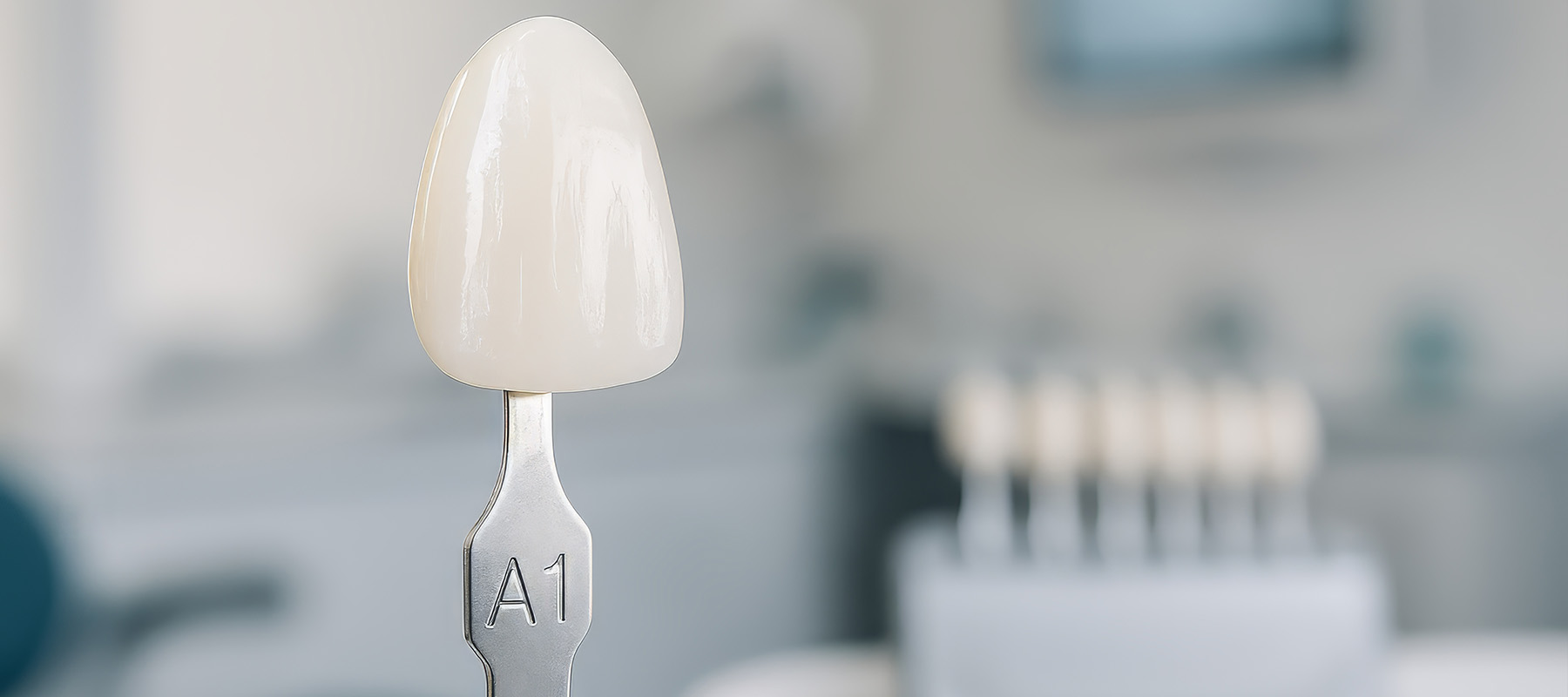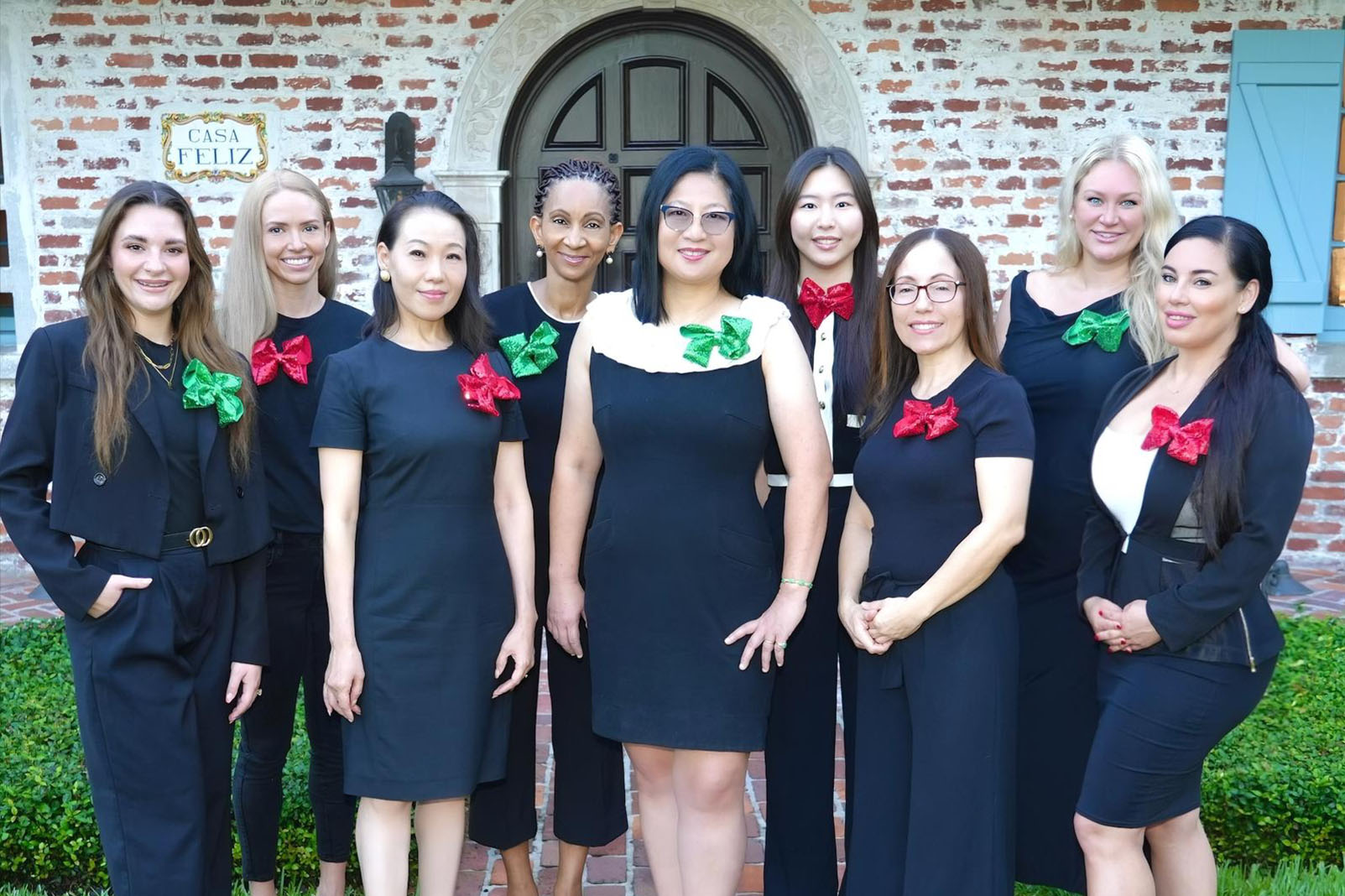
When it comes to dental restorations, one of the most important goals is ensuring your new crown, veneer, or filling blends seamlessly with your natural teeth. Our chairside color-matching technology elevates the process of finding the right shade to the next level. This advanced digital technology enables us to create natural-looking results and outstanding aesthetics that blend seamlessly with your smile.
Using a specialized digital device, we scan or photograph the teeth, capturing not only the exact shade but also other optical properties that influence how a tooth reflects light. This data is then analyzed and transmitted to fabricate the restoration. These precise, objective measurements exceed what the human eye alone can capture with traditional handheld shade guides, enhancing those findings while providing the exact requirements for more predictable and aesthetically appealing results.

Chairside color matching is a clinical process used to select the shade and optical properties of a dental restoration while the patient is in the treatment chair. The goal is to reproduce the natural color, translucency and surface texture of the adjacent teeth so the restoration blends seamlessly. This step reduces the need for repeated adjustments and helps the laboratory or in‑office milling system deliver a more predictable outcome.
During the appointment, the dentist evaluates color under controlled lighting, compares teeth to shade guides and often documents the selection with photographs and notes. The process accounts for variations in enamel thickness, staining patterns and underlying tooth structure that influence the final appearance. Accurate chairside matching improves aesthetic results for crowns, veneers, inlays and composite restorations.
The process begins with careful tooth preparation, cleaning and isolation so the surface is free of debris and moisture that can alter perceived color. The clinician uses calibrated shade guides, cross‑shaded tabs and sometimes neutral background materials to reduce visual bias when comparing hues. Photographic documentation with color reference cards helps capture the selection for laboratory communication or digital workflows.
After an initial shade is chosen, the dentist may perform trial restorations or provisional try‑ins to confirm the match under different lighting conditions. If adjustments are needed, the clinician notes modifications for the dental technician or modifies the restoration directly when using chairside milling or layering techniques. Final polishing and glazing are performed to achieve the correct surface luster and reflectance.
Clinicians rely on a combination of traditional and digital tools for reliable results, starting with standardized shade guides that represent common tooth colors and translucency levels. Advanced practices often use spectrophotometers or colorimeters to obtain objective shade measurements and reduce subjectivity introduced by human vision. Intraoral cameras and high‑resolution photography provide visual records that can be shared with dental technicians or stored in the patient chart.
Many offices integrate software that correlates digital readings with material libraries and specific ceramic or composite systems, which helps when planning layered restorations. Some chairside milling systems accept digital shade data directly, streamlining same‑day crown workflows. Together, these tools improve communication between the clinician and the laboratory and increase the predictability of aesthetic outcomes.
Lighting has a major impact on how color is perceived, so accurate matching requires neutral, color‑corrected illumination that mimics natural daylight. Color temperature and the absence of color casts from surrounding surfaces help ensure that shade selections are consistent and reproducible. Many clinicians use standardized daylight lamps or light boxes to minimize variations caused by office overhead lighting or windows.
Assessing the shade under multiple lighting conditions—indirect daylight, standardized clinical lamps and photos with a reference card—helps confirm the selection. Because enamel and ceramic materials respond differently under various light sources, verifying the match in more than one condition reduces the chance of surprises when the restoration is placed in the mouth. Consistent lighting protocols are a simple but powerful way to improve aesthetic results.
Underlying tooth structure, preparation depth and remaining enamel thickness all influence how light transmits and reflects through a restoration, which affects the perceived shade. Dentists evaluate the substrate and plan for appropriate masking strategies when there is discoloration or a dark core beneath the prepared surface. The final shade often requires compensation with opaque layers, specific ceramics or pigmented composites to neutralize unwanted underlying hues.
Different restorative materials have distinct optical properties: ceramics vary in translucency and fluorescence, and composite resins respond to layering techniques to mimic natural tooth anatomy. Choosing the correct material system and communicating its characteristics to the laboratory are critical for a harmonious match. Polishing, glazing and surface texture also contribute to how the restoration integrates visually with adjacent teeth.
Patients are invited to participate in the selection by reviewing shade options, viewing photographs and expressing preferences regarding brightness and translucency. The clinician explains how different choices will look in varied lighting and how whitening, adjacent restorations or natural variations may influence the final appearance. Educating patients about realistic outcomes helps set appropriate expectations and guides informed decision making.
At Fay Hu General Dentistry the team documents chosen shades with photographs and written notes so the patient can see and approve the plan before fabrication or final bonding. This collaborative approach ensures patient input is considered while maintaining professional standards for color science. Clear communication between the clinician, the patient and the laboratory reduces revisions and supports patient satisfaction.
Aesthetic restorations in the anterior zone such as veneers, crowns and single‑unit implant crowns most commonly benefit from careful chairside color matching due to their visibility when smiling or speaking. Inlays, onlays and composite restorations on visible surfaces also require precise shade selection to avoid noticeable transitions. Posterior restorations are sometimes less critical from an aesthetic standpoint but still benefit from appropriate color consideration for patient satisfaction.
When multiple adjacent teeth are being restored, coordinated shade mapping and documentation become especially important to achieve uniform results. Prosthetic work such as multi‑unit bridges or full mouth rehabilitations requires comprehensive planning to maintain harmony across restorations. Even in less visible areas, selecting complementary shades contributes to an overall natural appearance.
The time required for accurate chairside matching varies with the complexity of the case but typically ranges from a short targeted assessment to a more detailed session when multiple shades or photographs are needed. A straightforward single‑tooth selection can often be completed in ten to twenty minutes, while cases that require trial restorations, layered composites or additional photographic documentation may take longer. The clinician factors in tooth preparation, patient consultation and any necessary try‑ins when estimating appointment length.
Scheduling considerations depend on whether the restoration is being fabricated in‑office or sent to an external laboratory, since each workflow has different timing needs. At our Winter Park office we coordinate shade selection with the planned restoration timeline to minimize delays and ensure proper documentation. Clear communication about the steps involved helps patients plan their visits effectively.
Long‑term color stability depends on proper material selection, meticulous finishing and appropriate home care to limit staining factors such as tobacco, strong pigments and certain beverages. Clinicians finish restorations with polishing and glazing protocols that reduce surface roughness and make the material less prone to extrinsic staining. Selecting ceramics or composites with proven resistance to discoloration helps preserve the original match over time.
Regular professional cleanings and periodic evaluations allow the dental team to monitor the restoration and address minor surface changes before they become noticeable. If polishing or minor adjustments are needed, they can often be performed chairside to refresh the appearance. Patient education on oral hygiene and lifestyle influences complements clinical measures to sustain a uniform smile.
Fay Hu General Dentistry follows standardized protocols for shade taking, photographic documentation and material selection to promote consistent outcomes across restorations. The team records shade information in the patient chart, uses calibrated instruments and communicates detailed notes to the laboratory or in‑office milling system to align expectations. Ongoing staff training and quality checks on try‑ins and final seating support predictable aesthetic results.
When complex shade matching is required, the practice coordinates closely with trusted dental technicians and may perform incremental try‑ins or adjustments to refine the match. By combining objective measurements with clinical experience and thorough documentation, the office achieves reliable color harmony for single‑tooth and multi‑unit cases alike. This systematic approach reduces remakes and helps patients achieve natural‑looking restorations.

We are dedicated to providing the highest quality of dental care to our patients.
Through excellence in dentistry and quality in relationships, we strive to positively impact your oral health, aesthetics, and self-esteem. From the front desk to the treatment room, our experienced team is here to support you with expert care and genuine compassion.